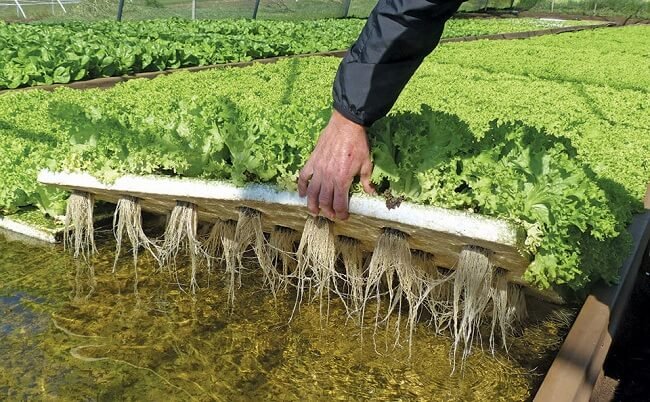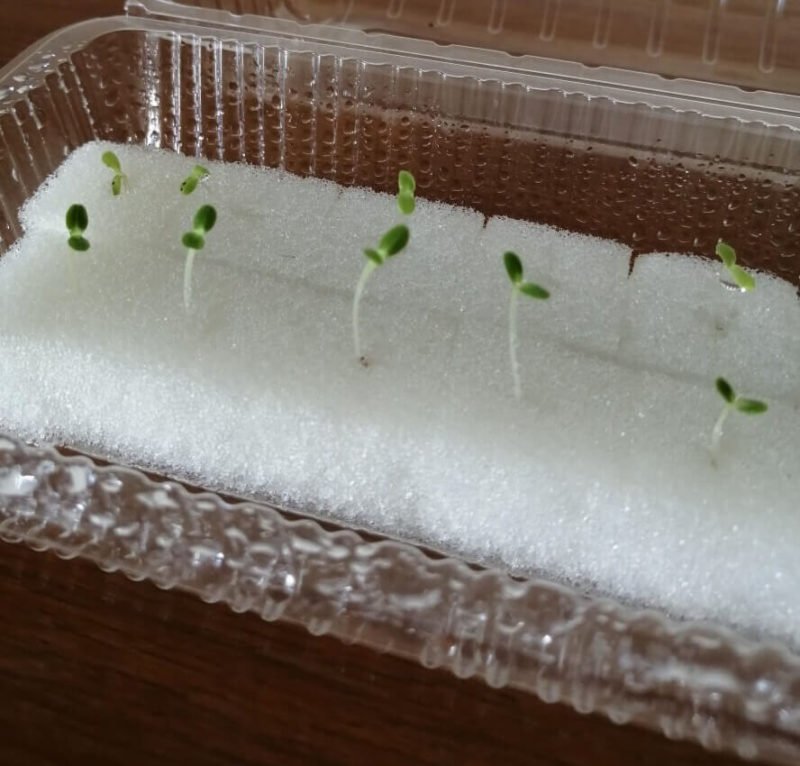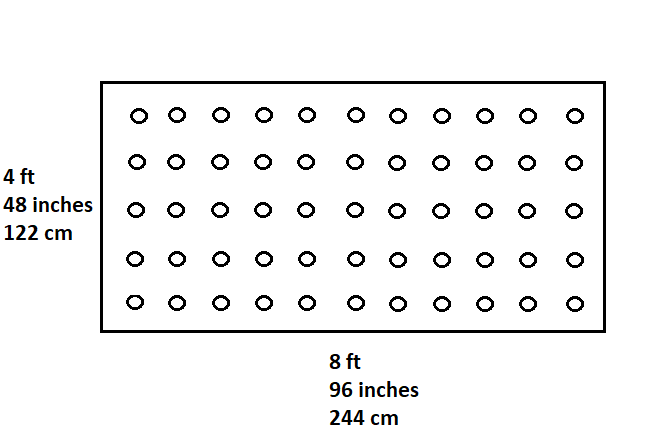Aquaponics is the system of growing plants in water, fish are also kept in the water. The fish provide the waste which is naturally turned into nutrients by the bacteria in the system and ensures the plants have a healthy supply of food.
In effect, it’s a self-contained system, although there are aspects that need to be monitored regularly.

There are many different plants that can be grown this way but lettuce aquaponics or growing lettuce together with fish waste one of the most popular options. It’s a great starting plant too.
Methods of Growing Lettuce in Aquaponics
Using the right method you should be able to get a crop of lettuce in 4-5 weeks, that’s pretty impressive and a great reason to start with lettuce.
Although there are multiple ways of growing plants in aquaponics, the following two are the easiest approaches when growing lettuce, and are likely to give the highest yields.
Floating Raft or Deep Water Culture (DWC)
The raft method involves having a permanent supply of water, as opposed to the ebb and drain approach. The raft is a piece of polystyrene or something similar that can float on the water, hence the expression ‘lettuce in rafts’. Each lettuce seed is placed in a hole in the raft. Rockwool or foam sponges are one of the most popular options for this.

The roots of the lettuce plant will hang in oxygenated water which is being pumped through the growing section to the fish tank, and then back to the lettuce growing area. This gives the roots perfect access to all the nutrients they need to grow healthy and strong, very quickly.
The best part is that once you’ve put the seedlings into the rafts, there is very little for you to do except for monitoring their growth and maybe transplanting them once to optimize space.
Growbeds
Another option is to use grow beds. In fact, lettuce in grow beds can also do exceptionally well. The main difference is that the roots of these plants will not sit in water all the time. This method of lettuce production involves you creating growbed that the seedlings are planted into. The bell siphon will take care of the flood and drain cycle of the growbed.
This gives the lettuce plants the water, nutrients, and oxygen they need, helping them to grow in the same way as they would using a raft system.
There are different types of seed starter cubes you can use, although it’s generally agreed that rockwool is one of the favorite choices.
Best Conditions For Lettuce Aquaponic Growth
In order for your lettuce to survive and flourish you need to have the very best conditions for it. That means understanding where the lettuce should be planted, what the best pH for lettuce is, and what sort of temperatures are required.
Water and Air
Lettuce thrives when the water temperature is between 70 and 74°F (21-23°C), this is also a good temperature for many fish, which is why lettuce is a good match for most aquaponics systems. Airflow in the grow room is also important to increase transpiration and the uptake of nutrients.
In short, setting up your system to grow lettuce is simple and can then be used for multiple other plants.
Ph levels
Your lettuce plants will be very happy if the pH level is between 5.8 and 6.2. However, it is a fairly robust crop and can survive with pH levels outside this range. Obviously, it may not become as large or taste as good if the range is not maximized.
It should be noted that while the pH is a little flexible, lettuce will benefit from higher levels of calcium in the water. This can discourage tip burn on their leaves during the height of summer.
Space needed
If you want the best yield you should aim to plant 1 lettuce every 7 inches, this will give you the best lettuce per square feet and encourage maximum growth without the lettuce taking each other’s nutrients or blocking the light to each other. This spacing will also depend on the kind of lettuce. Rocket lettuce needs less space than butterhead lettuce.

In this image, you see a deep water culture raft that has 55 holes. 11 horizontally and 5 vertical. The edges have 4 inches of space.
Pests To Be Aware Of
Aquaponics systems generally suffer from less pests than traditional gardening systems. This is partly because of the lack of soil and partly because its easier to be vigilant with an aquaponics system.
However, that doesn’t mean there aren’t any pests when you’re growing lettuce you should be particularly careful about what pest control measures you use, you will want to eat the lettuce. That means no pesticides, they can be nearly as harmful to you and your fish as they are to the pests.
Instead, you’ll have to try using predator bugs, or beneficial insects, that’s insects that eat the pests without being interested in eating the lettuce themselves. Ladybugs are a great example of this.
Of course, you can physically remove any pest you can see, this can ensure your plants are free of the larger pests. But, it’s tedious and slow. A better idea is to intersperse your lettuce with plants that pests don’t like, such as chives, or mint.
This will increase the variety of your aquaponics set up and help your lettuces to flourish.
A viable alternative is simply to pace a bug net over your plants, that should stop anything from getting to close to your plants.
Final Thoughts
Lettuce aquaponics is a great introduction to the world of aquaponics. It can be fun creating rafts and watching the plants grow. Of course, you’ll need to follow the guidelines above, this will help to ensure your first aquaponics attempt is successful.
The beauty of aquaponics is that it is easy to set up and maintain the system. You can then try lettuce aquaponics or any other plant that you like to eat. With just a little tweaking you can discover how to effortlessly grow your own crop and enjoy them.

Nick loves building, managing and giving others advice on aquaponics. He created this website to do just that. He is the author of Aquaponics for beginners. If you got a question contact him here or read more on the about page here.
